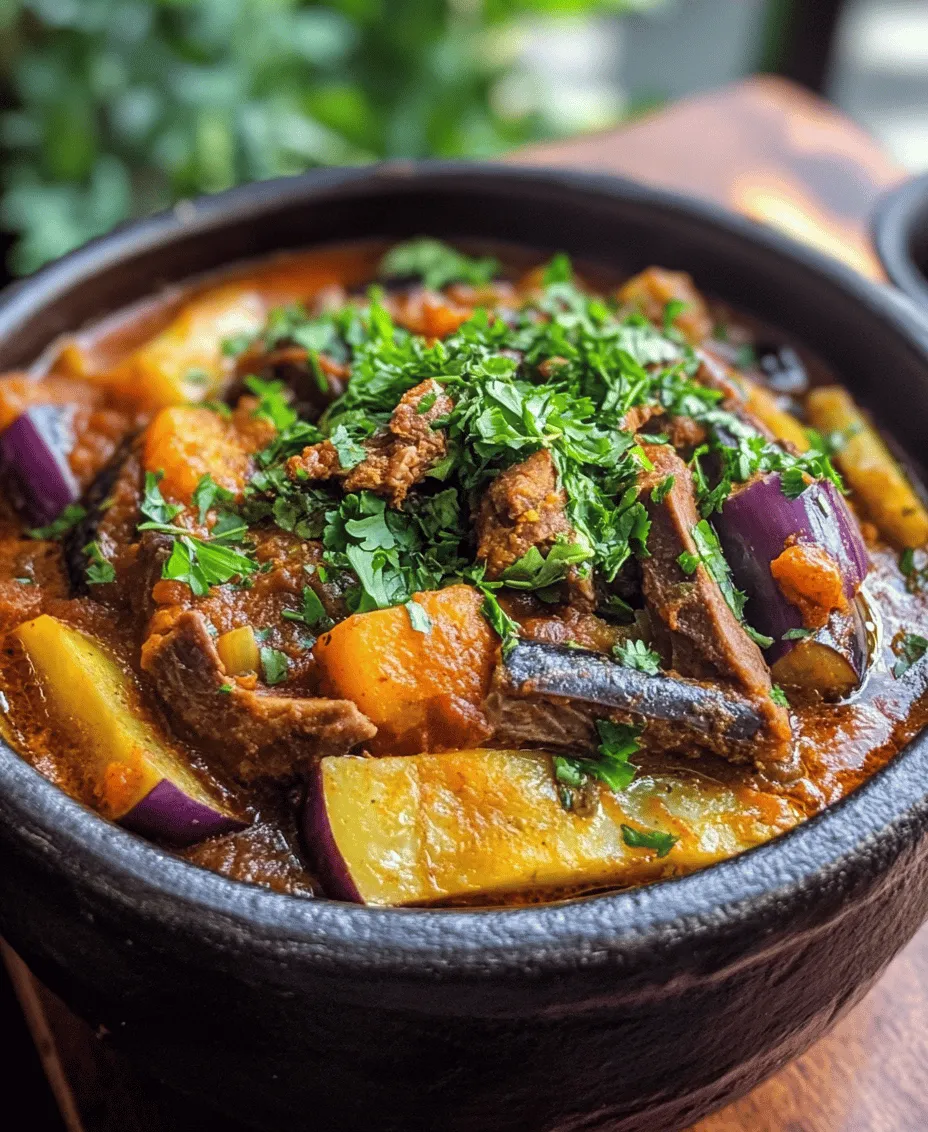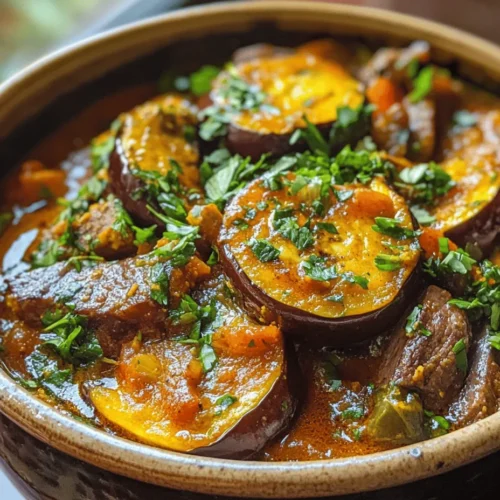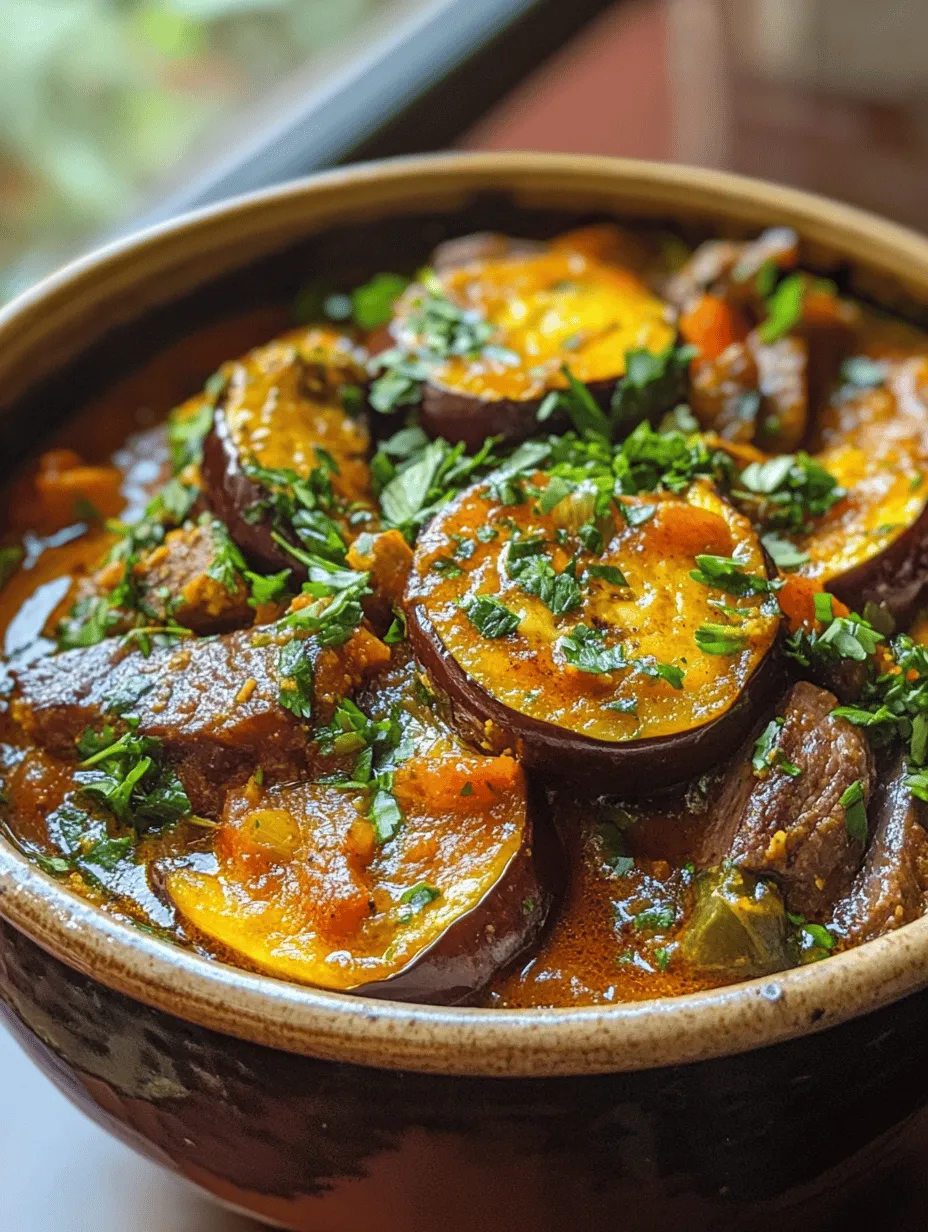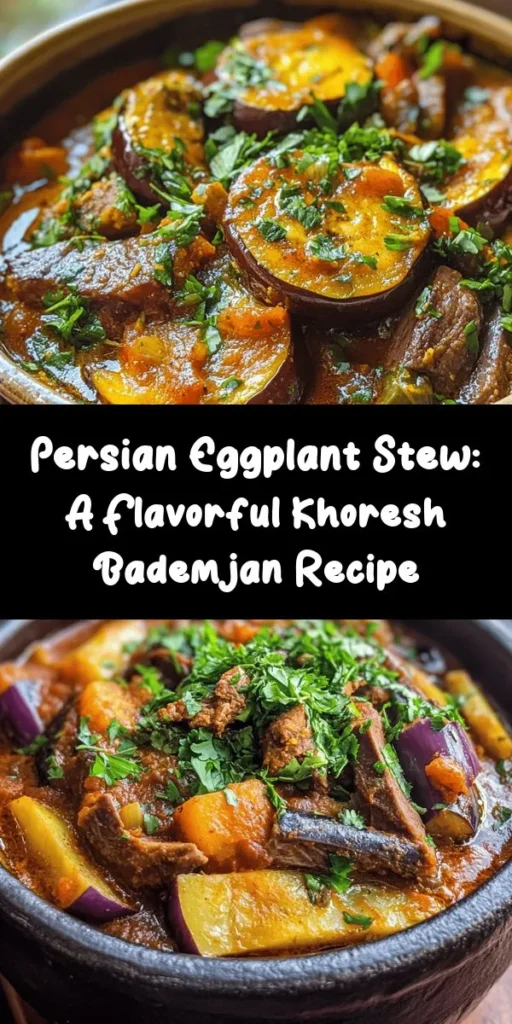Introduction
Khoresh Bademjan is a beloved Persian stew that encapsulates the heart and soul of Iranian cuisine. This dish, which translates to “eggplant stew,” is a delightful fusion of tender meat, rich eggplant, and aromatic spices that come together to create a comforting and flavorful experience. Traditionally served alongside fluffy basmati rice, Khoresh Bademjan is often a centerpiece at family gatherings and festive occasions, embodying the warmth and hospitality of Persian culture.
The cultural significance of Khoresh Bademjan extends beyond mere nourishment; it symbolizes togetherness and shared meals, often enjoyed in the company of loved ones. The richness of its flavors and the tender texture of the ingredients evoke a sense of nostalgia for many, reminding them of home-cooked meals and the care that goes into preparing such a cherished dish.
One of the most appealing aspects of Khoresh Bademjan is its versatility. While the classic recipe traditionally features lamb or beef, it can easily be adapted to suit vegetarian diets by substituting meat with hearty legumes or mushrooms. This adaptability makes Khoresh Bademjan accessible to a wide range of dietary preferences, ensuring that everyone can partake in this delectable Persian love affair with eggplant.
As we delve into the world of Khoresh Bademjan, we will explore the key ingredients that define this iconic dish and outline the preparation steps to help you recreate its magic in your own kitchen.
Exploring the Ingredients
Eggplant
At the heart of Khoresh Bademjan lies the eggplant, a vegetable that is revered for its unique texture and ability to absorb flavors. In this stew, eggplants are not just a supporting player; they are the star of the show. Their creamy consistency and slightly sweet undertones provide a beautiful contrast to the savory elements of the dish.
However, to unlock the full potential of eggplant, it is crucial to prepare them properly. Many cooks recommend salting the eggplants before cooking to remove any bitterness and excess moisture. This process involves slicing the eggplants, sprinkling them with salt, and allowing them to sit for about 30 minutes. Afterward, the eggplants are rinsed and patted dry, resulting in a tender and flavorful addition to the stew.
Meat Choices
Khoresh Bademjan typically features either lamb or beef, both of which contribute distinct flavors to the stew. Lamb, with its rich, gamey profile, adds warmth and depth, while beef offers a heartier, more robust flavor. For those opting for a vegetarian alternative, ingredients such as chickpeas or lentils can be used to create a satisfying and nutritious version of this classic dish. The choice of meat—or the absence of it—significantly impacts the overall taste, allowing for personal preferences to shine through.
Aromatics
The foundation of any great Persian dish lies in its aromatics, and Khoresh Bademjan is no exception. Onions and garlic are sautéed at the beginning of the cooking process, infusing the dish with their fragrant qualities. The onions should be cooked until they are golden and caramelized, bringing out their natural sweetness and creating a savory base for the stew. Garlic, when added, enhances the aroma and flavor profile, creating a tantalizing aroma that invites everyone to the table.
Tomatoes
Tomatoes play a vital role in Khoresh Bademjan, providing acidity and richness to the stew. Cooks can choose between fresh tomatoes or canned varieties, both of which bring their own unique characteristics to the dish. Fresh tomatoes offer a bright, vibrant flavor, while canned tomatoes provide a concentrated sweetness that can enhance the overall richness of the stew. Regardless of the choice, tomatoes add depth and balance, tying the flavors of the dish together beautifully.
Spices
No Persian dish is complete without the signature spices that define the cuisine. In Khoresh Bademjan, turmeric, cinnamon, and saffron are essential players. Turmeric lends a warm, golden hue and a mild earthiness, while cinnamon introduces a subtle hint of sweetness that rounds out the dish. Saffron, often referred to as the “golden spice,” adds an aromatic complexity and a richness that elevates the stew to another level. Beyond their flavor contributions, these spices also boast various health benefits, making Khoresh Bademjan not only delicious but also a nourishing option.
Broth
The choice of broth can significantly impact the flavor of Khoresh Bademjan. Typically, chicken or vegetable broth is used, providing a liquid base that enhances the stew’s taste. Chicken broth adds a layer of richness and depth, while vegetable broth offers a lighter, more nuanced flavor. Regardless of the choice, a quality broth is essential for achieving a well-rounded and flavorful stew.
Preparation Steps
Preparing the Eggplants
The first step in creating Khoresh Bademjan involves preparing the eggplants. Begin by slicing the eggplants into thick rounds or half-moons, depending on your preference. Generously sprinkle salt over the slices and allow them to sit for about 30 minutes. This salting process helps to draw out any bitterness and excess moisture, resulting in a more tender and flavorful final dish.
After the eggplants have rested, rinse them under cold water to remove the salt and pat them dry with a clean kitchen towel. Next, heat a generous amount of oil in a frying pan over medium heat and fry the eggplant slices until they are golden brown on both sides. This step not only enhances their flavor but also adds a delightful texture to the dish. Once fried, set the eggplants aside on a paper towel to absorb any excess oil.
Sautéing Aromatics
The next stage involves sautéing the aromatics, which will form the base of the stew. In a large pot or Dutch oven, heat a couple of tablespoons of oil over medium heat. Add finely chopped onions and cook them slowly, stirring occasionally, until they become golden and translucent. This process can take about 10 to 15 minutes; patience is key, as the caramelization of the onions is crucial for developing the stew’s flavor.
Once the onions are perfectly sautéed, add minced garlic to the pot and cook for an additional minute until fragrant. The combination of onions and garlic creates an aromatic foundation that will elevate the stew’s overall flavor profile.
Browning the Meat
Next, it’s time to add the meat of your choice to the pot. Increase the heat to medium-high and add your lamb or beef, ensuring that the meat is cut into bite-sized pieces. Allow the meat to brown on all sides, which should take about 5 to 7 minutes. This browning process is essential for developing a rich, deep flavor in the stew, as it creates a Maillard reaction that enhances the taste of the meat.
Combining Ingredients
Once the meat is browned, it’s time to combine the ingredients. Add the sautéed onions and garlic to the pot along with the fried eggplant slices, diced tomatoes (fresh or canned), and the chosen broth. Stir everything together gently to combine, being careful not to break apart the eggplant slices. This layering of flavors is crucial for achieving a well-balanced and rich stew.
Final Assembly
To finish assembling your Khoresh Bademjan, add the spices: turmeric, cinnamon, and saffron. Stir to ensure that the spices are evenly distributed throughout the mixture. Bring the stew to a gentle simmer, then reduce the heat to low and cover the pot. Allow it to cook for about 1.5 to 2 hours, stirring occasionally, until the meat is tender and the flavors have melded beautifully. The slow cooking process allows the ingredients to develop a deep, harmonious flavor that is characteristic of traditional Persian stews.
As the Khoresh Bademjan simmers, the house will be filled with a tantalizing aroma that beckons everyone to the kitchen. This is the perfect time to prepare your basmati rice, which will serve as the ideal accompaniment to this rich and flavorful stew.
With the preparation steps laid out, you are now well on your way to creating a dish that not only celebrates the love for eggplant but also embodies the warmth and richness of Persian cuisine. Stay tuned for the next part, where we will delve into serving suggestions, variations, and tips for achieving the perfect Khoresh Bademjan.

Cooking Techniques
When it comes to Khoresh Bademjan, the interplay of cooking techniques plays a pivotal role in achieving the dish’s distinctive flavor and texture. Two primary methods contribute to the success of this Persian stew: frying and stewing.
Frying vs. Stewing
The first step in crafting Khoresh Bademjan typically involves frying the eggplant and meat. This step is critical as it enhances the overall flavor profile of the dish. When you fry the eggplant, it caramelizes, developing a rich, complex taste. Browning the meat in oil not only seals in its juices but also creates a depth of flavor that forms the foundation of your khoresh.
However, frying is just the beginning. After the frying process, the ingredients must be stewed together. This slow cooking method allows all the components to meld beautifully. As the khoresh simmers gently, the spices and flavors harmonize, creating a dish that is greater than the sum of its parts. The science behind this is simple: simmering at low heat allows the flavors to infuse into each other, resulting in a rich, aromatic dish that is full of character.
Flavor Meld
The process of simmering is essential in Persian cooking. It not only softens the vegetables and meat but also allows the spices to release their essential oils. Spices such as turmeric, saffron, and cinnamon, when simmered, deepen in flavor and fragrance. The slow cooking process ensures that each bite of Khoresh Bademjan is packed with a medley of tastes, from the sweet warmth of the caramelized onions to the savory richness of the meat and the earthiness of the eggplant.
Serving Suggestions
Khoresh Bademjan is a dish that not only delights the palate but also presents beautifully. When it comes to serving this beloved Persian stew, there are several accompaniments that elevate the dining experience.
Accompaniments
Traditionally, Khoresh Bademjan is served with fluffy basmati rice. The rice, often steamed with a bit of saffron for added aroma and color, acts as the perfect canvas for the khoresh. The grains of rice soak up the rich sauce, creating a satisfying and hearty meal. For those who prefer a more rustic approach, serving Khoresh Bademjan with warm, freshly baked Persian bread, such as lavash or sangak, is a wonderful option. The bread can be used to scoop up the stew, making it a hands-on and communal dining experience.
For an added touch, consider serving some pickled vegetables, known as torshi, on the side. These tangy accompaniments provide a delightful contrast to the rich flavors of the khoresh, refreshing the palate between bites.
Garnishes
Presentation is key when serving Khoresh Bademjan. A sprinkle of freshly chopped herbs, such as parsley, cilantro, or mint, not only enhances the visual appeal of the dish but also adds a burst of freshness that balances the richness of the stew. Additionally, a few slices of lemon or lime can be served on the side, allowing guests to add a squeeze of citrus for an extra layer of flavor.
Nutritional Information
Khoresh Bademjan is not only a feast for the senses but also a nutritious meal. Understanding the health benefits of its ingredients can enhance your appreciation of this dish.
Eggplant
Eggplant, the star of Khoresh Bademjan, is low in calories and high in fiber, making it an excellent choice for those looking to maintain a healthy diet. This vegetable is also rich in antioxidants, particularly nasunin, which is known to support brain health and reduce inflammation. The fiber content aids in digestion and contributes to a feeling of fullness, making it a satisfying ingredient in any meal.
Meat
If you choose to include meat in your Khoresh Bademjan, you benefit from the protein it provides. Protein is essential for building and repairing tissues, and it also plays a crucial role in producing enzymes and hormones. Opting for lean cuts of meat can help keep the dish heart-healthy while still delivering the savory flavors that complement the eggplant.
Herbs and Spices
The herbs and spices used in Khoresh Bademjan not only add depth to the flavor but also come with their own set of health benefits. Turmeric, for example, is renowned for its anti-inflammatory properties and is believed to support joint health. Saffron, another key ingredient, is packed with antioxidants and has been linked to improved mood and cognitive function. The inclusion of spices like cinnamon can help regulate blood sugar levels, making them a smart addition to your diet.
Cultural Context
Khoresh Bademjan holds a special place in Persian cuisine, steeped in family traditions and cultural significance.
Family and Tradition
In Persian households, preparing Khoresh Bademjan is often a communal activity that brings family members together. The process of frying the eggplant, sautéing the meat, and simmering the stew can become a cherished ritual, often passed down through generations. Families might gather in the kitchen, sharing stories and laughter as they prepare this beloved dish. It is not uncommon for recipes to be slightly modified to reflect individual family traditions, making each version of Khoresh Bademjan unique.
Festive Occasions
Khoresh Bademjan is more than just a meal; it is often served during festive occasions and gatherings. Whether for a family reunion, a wedding, or a holiday celebration, this dish symbolizes hospitality and warmth. Sharing Khoresh Bademjan with loved ones encapsulates the essence of Persian culture, where food plays a crucial role in bringing people together. The inviting aroma of the stew simmering on the stove often beckons family members to the dining table, fostering a sense of togetherness and joy.
Conclusion
Khoresh Bademjan is not merely a dish; it is an experience that encapsulates the warmth of home-cooked Persian meals. With its rich blend of flavors, aromatic spices, and the comforting textures of eggplant and meat, this khoresh invites you to explore the depths of Persian cuisine. From the careful balance of frying and stewing to the thoughtful garnishes that elevate its presentation, every aspect of Khoresh Bademjan is crafted with love and intention.
As you prepare to serve this dish, consider the traditional accompaniments of basmati rice or Persian bread, and don’t forget the fresh herbs that add a final touch of brightness. Embracing the cultural significance of Khoresh Bademjan allows you to connect with the heart of Persian culinary heritage, making each meal a celebration.
We encourage you to try your hand at this delightful stew, inviting its rich flavors into your kitchen and sharing it with friends and family. As you savor each bite, you’ll discover why Khoresh Bademjan is truly a love affair with eggplant that transcends time and tradition.



